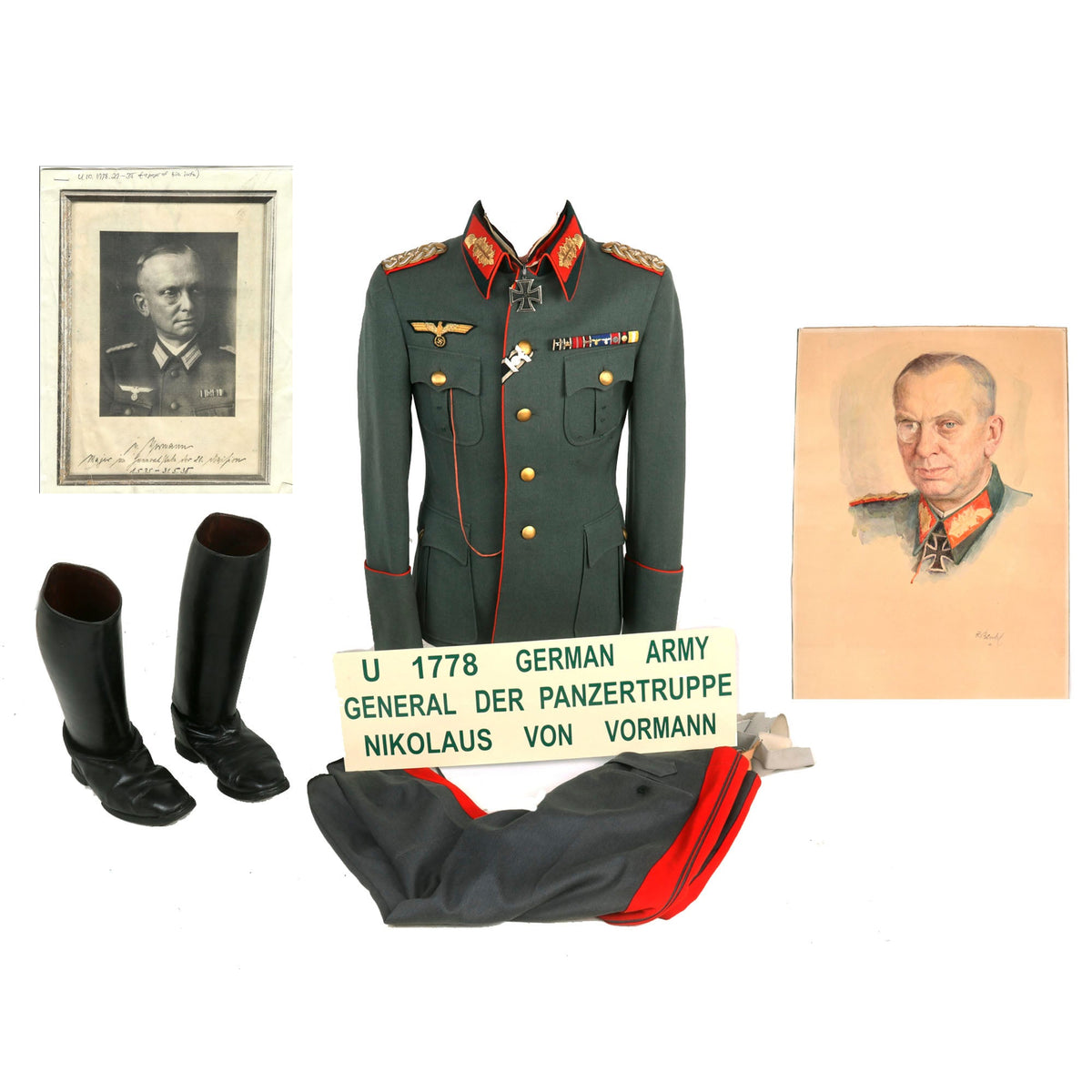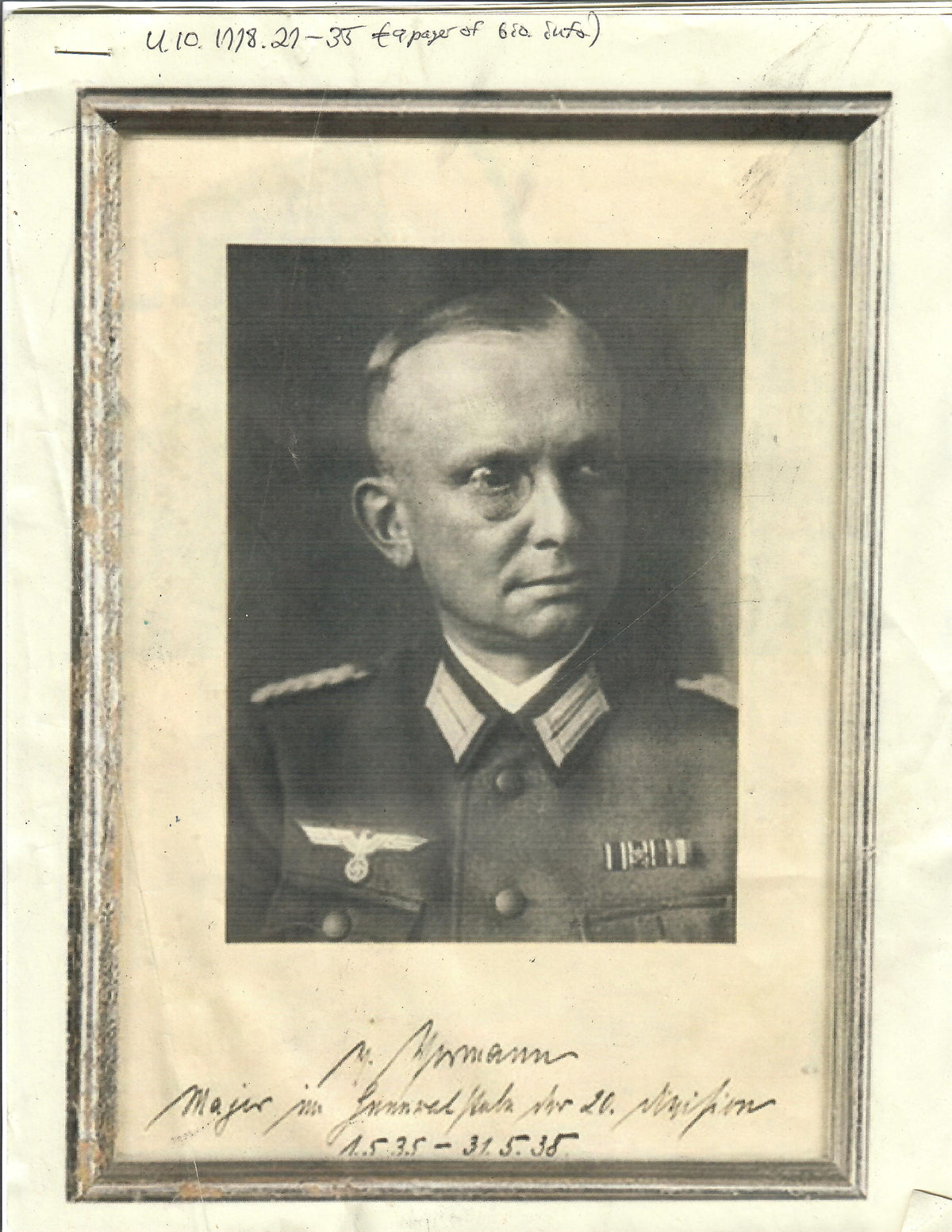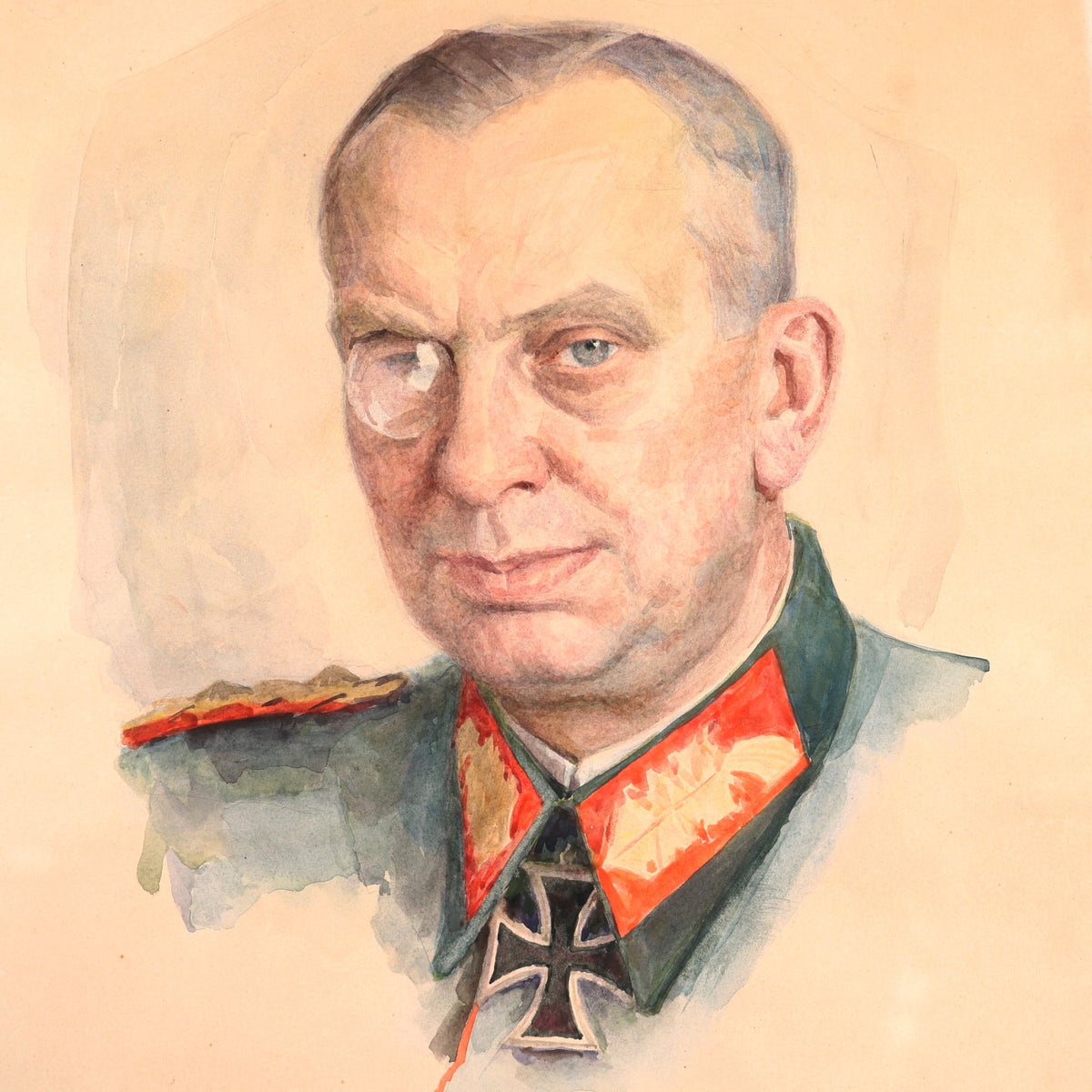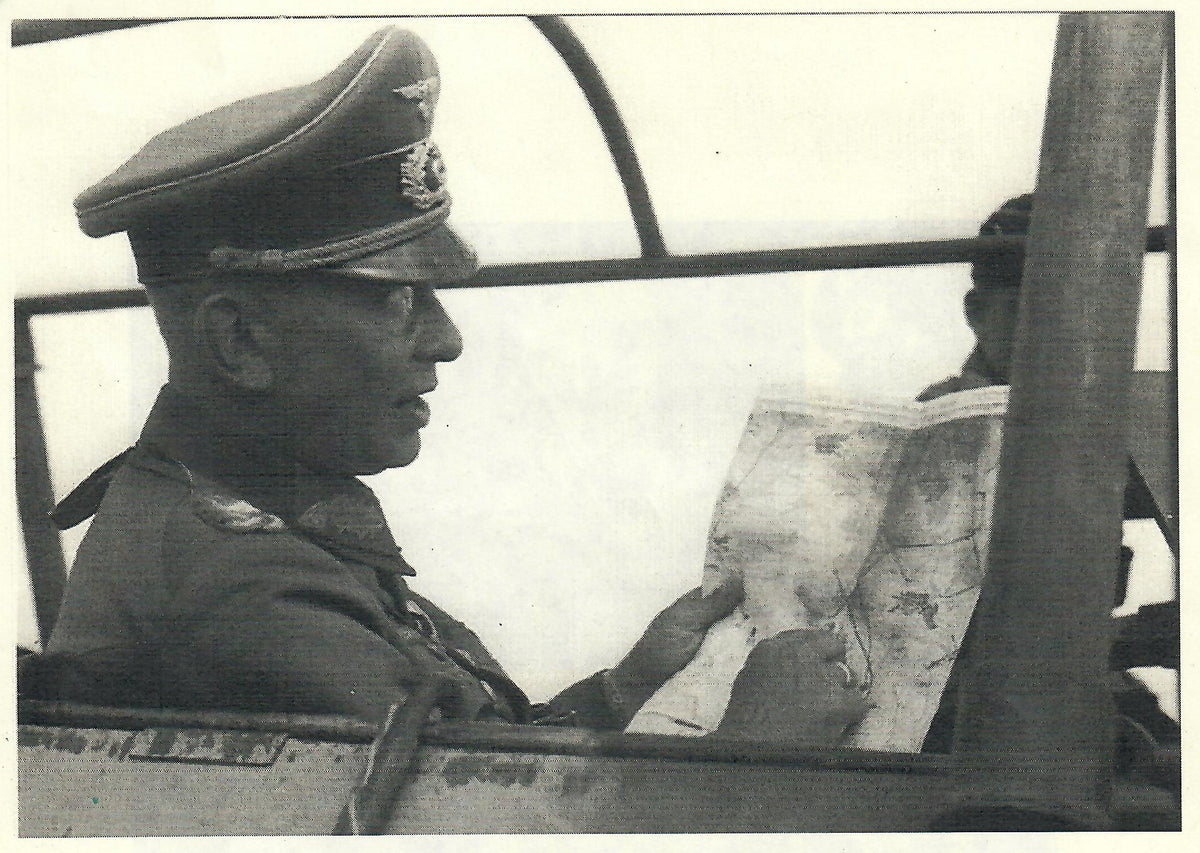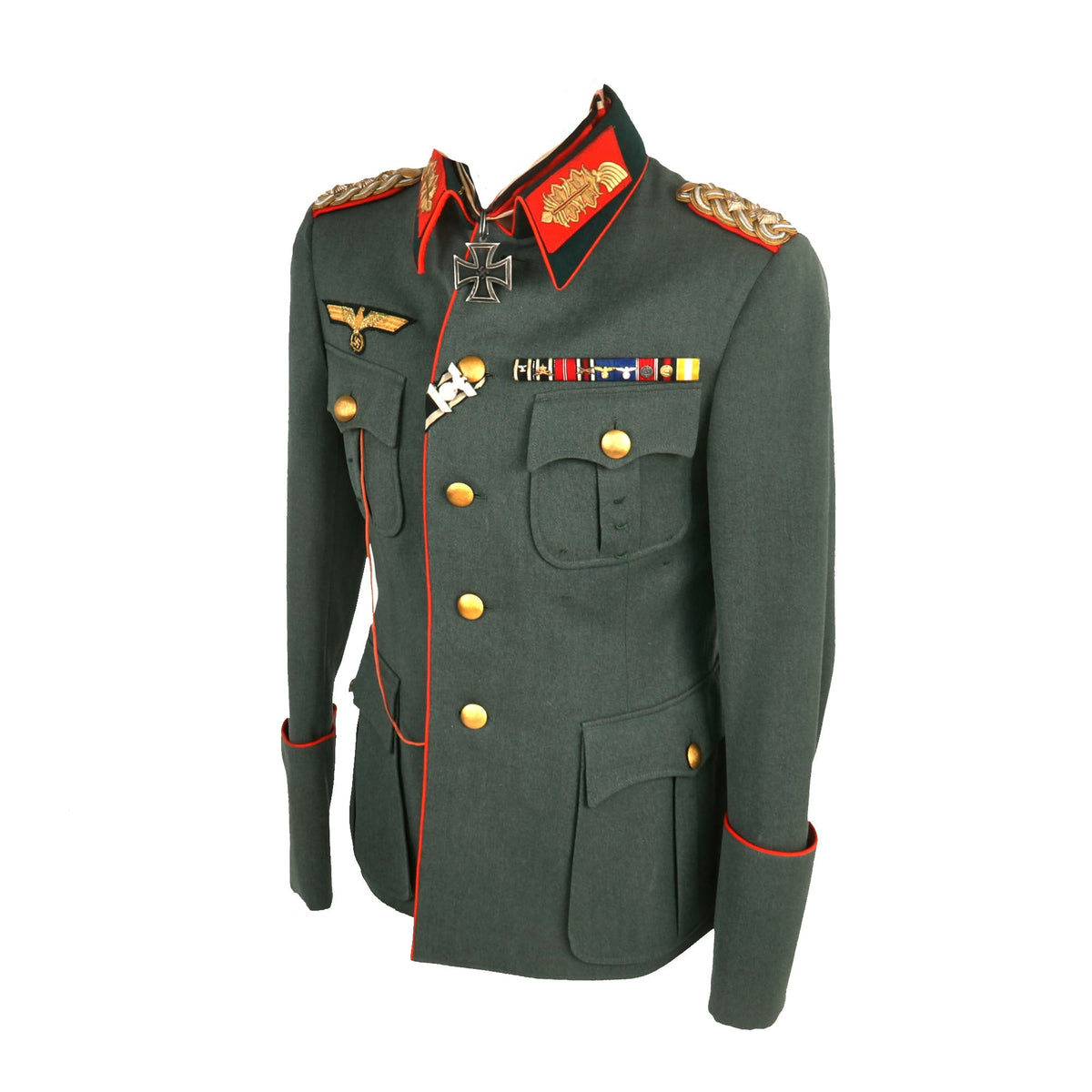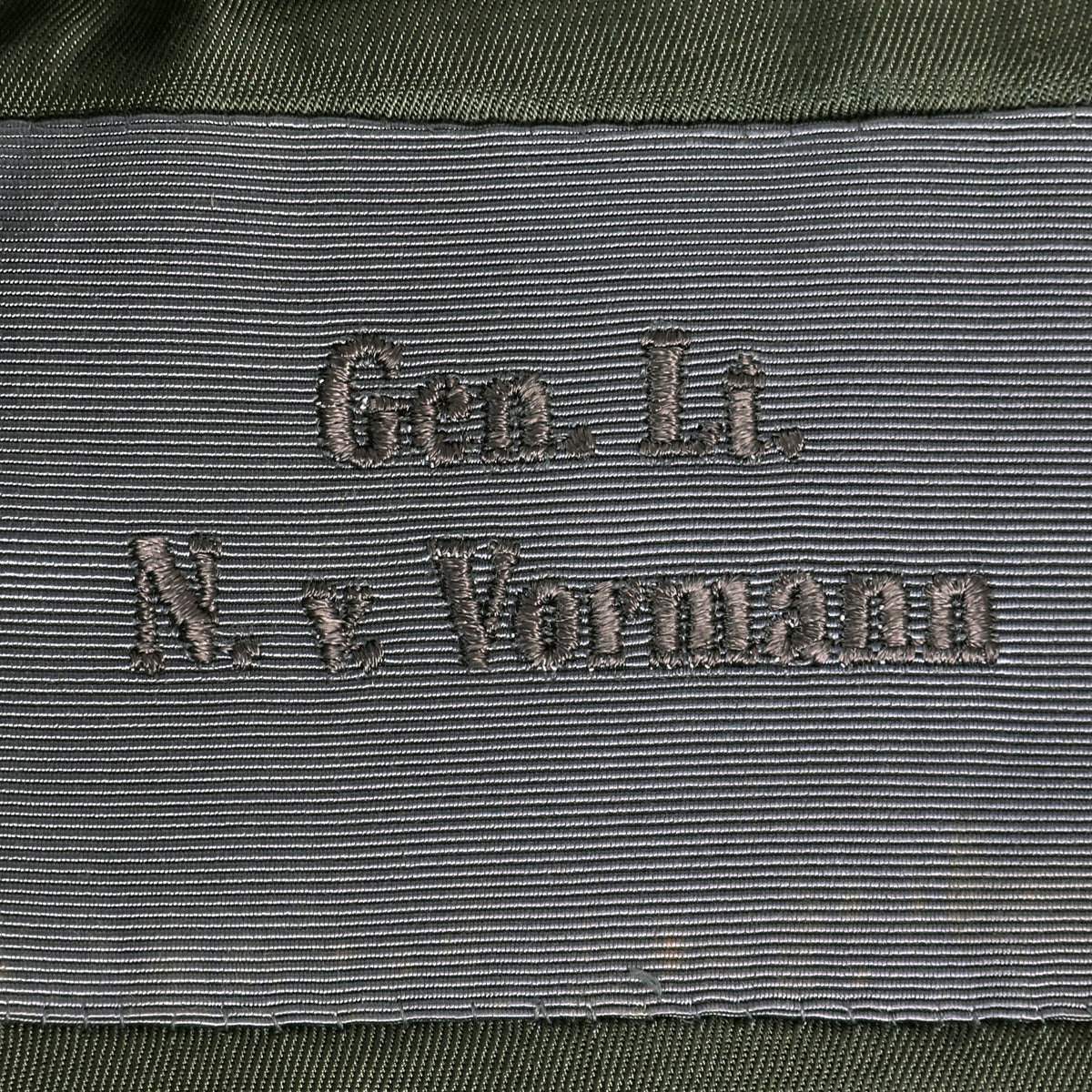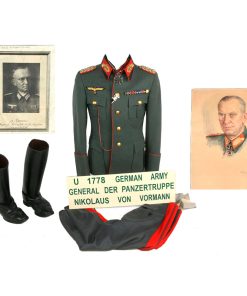Original German WWII 23rd Panzer Div. & XLVII Panzerkorps Commander General der Panzertruppen Nikolaus von Vormann Uniform Set – Formerly Part of the A.A.F. Tank Museum Original Items
$ 9.995,00 $ 2.498,75
Original Items: One-of-a-kind set. Nikolaus von Vormann (24 December 1895 – 26 October 1959) was a German Panzertruppe General in the Heer Army during World War II, who commanded the 23rd Panzer Division and later the XLVII Panzer Corps during his WWII service. Originally an Oberstleutnant (Lt. Colonel) at the beginning of the war, he eventually rose to the rank of General der Panzertruppe (Lt. General) at the end of the war when commander of the XLVII Panzerkorps. He was a recipient of the Knight’s Cross of the Iron Cross, as well as many other prestigious awards.
This wonderful German WWII Named Uniform Set came to us from the American Armoured Foundation, Inc. Tank and Ordnance Memorial Museum. The AAF Tank Museum was a living memorial dedicated to the Tank and Cavalry soldiers of the world. Before 1981 some of the artifacts that make up the AAF Tank Museum was a private collection belonging to Mr. William Gasser. Mr. Gasser felt that his collection would be beneficial in educating present and future generations to the sacrifices made and the technologies gained during war. Therefore, in 1981 the AAF Tank Museum was established as a non-profit charitable organization, and Mr. Gasser’s donated his private collection to the Tank Museum. Mr. Gasser is still active as Volunteer Director and Curator of the Tank Museum and his knowledge of military history has been a great asset to the museum. Unfortunately after 20 years of operation it had to close its doors, which is when this set was acquired.
Born 24 December 1895, Nikolaus von Vormann joined the Prussian Army in 1914, and was commissioned as a Leutnant (2nd Lieutenant) in the 26th (1st Magdeburg) Infantry “Prince Leopold of Anhalt-Dessau” Regiment, after serving as a cadet, and received several awards during his service. He would later continue his military service as a member of the Reichswehr under the Weimar republic. He was a career soldier, and continued his service after the NSDAP takeover of Germany.
He was well-decorated, and the following is a list of awards we have been able to locate, along with the dates they were bestowed, if available:
● Wound Badge in Gold (for wounds received during World War I)
● Iron Cross (1914)
– 2nd Class
– 1st Class
● Knight’s Cross with Swords of the Royal House Order of Hohenzollern (18 June 1915)
● Iron Cross (1939)
– 2nd Class (spange – 20 October 1939)
– 1st Class (spange – 25 June 1940)
● Eastern Front Medal (Ostmedaille) – 25 July 1942
● German Cross in Gold on 12 March 1942 as Oberst im Generalstab (in the General Staff) in the Generalkommando of the XXVIII. Armeekorps
Most notably, he was awarded the Knight’s Cross of the Iron Cross on 22 August 1943 as Generalleutnant and commander of the 23. Panzer-Division. It should also be noted that due to his long service he would have qualified for the Wehrmacht Long Service awards, and other awards not listed. Many of these are represented in the medal bar his uniform bears, which also looks to have some awards not mentioned on listings that we have. The 2nd buttonhole from the top is fitted with a 1914 EKII ribbon, with the correct 1939 clasp. It is also fitted with a “Field Upgraded” Knight’s Cross (an EKII with Ribbon) to take place of the Friedrich order Knight’s Cross.
The lovely M36 uniform tunic in this set was is a lovely bespoke example, still bearing the maker tag at the back of the collar, which reads:
FEINE MASSCHNEIDEREI
Wilh. Sartorius
HELMARSHAUSEN
More importantly, there is an embroidered label on the left interior that reads Gen. Lt. N. v. Vormann. Based on this we believe the tunic was made at some time in 1943 due to the rank. This indicates that when von Vormann was promoted to General der Panzertruppen during 1943-1944, he would have had to add an additional rank pip to his shoulder insignia, or had them replaced outright.
The tunic is really a great example of a private purchased Wehrmacht Heer Generäle Dienstbluse (General Officer Service Tunic). It is constructed from a fine quality field-gray “whipcord” wool woven exterior, with a green cotton-rayon blended interior lining. The sleeves are lined with the usual blue / gray striped rayon. The collar is constructed of flaschengrün (dark bottle-green) wool, and is adorned by a set of General grade collar tabs, known as alt-Larisch or Arabesque style, which were used for all General ranks below Feldmarschall. These have the correct red backgrounds with gold bullion embroidery. and the collar edge, front closure, and the cuffs are piped with red as well.
The tunic conforms well to the M36 pattern, having 4 pleated pockets on the front with scalloped flaps. All of the pebbled buttons are the correct gold color for a General officer, and all look to be maker marked on the back.
Each shoulder is decorated with the sew-on style General der Panzertruppen rank shoulder boards. They are both constructed out of a row of interwoven silver and gold bullion strands in the typical Russian braid style in an interlocking weave pattern ending at a pebbled gilt metal (magnetic) button. There are two rank pips installed, correct for a General der Panzertruppen and other specialized General ranks equivalent to a U.S. Army Lt. General.
On the right breast is a fine quality gold bullion eagle, constructed of rolled, twisted, and flat hand embroidered gilt stitching with gold cotton retaining threads, placed onto a dark bottle green wool backing. It is neatly stitched to the outer layer of fabric, which is still bright and shiny. really a lovely looking tunic, showing just a bit of wear.
Along with the tunic there is a lovely pair of General’s breeches / jodhpurs in the correct stone gray (steingrau) color, with red stripes on the side, which comes with the correct suspenders. They are in very good shape, and definitely period correct. Even better, they have a lovely embroidered label on the interior, which reads Gen. Lt. N. v. Vormann. Based on this we believe they were acquired some time in 1943 due to the rank.
Finishing out the set is a lovely set of German WWII officer’s tall jackboots, which are in very good condition, and look to be a matched pair! They do not have any markings, but have identical leather soles with metal guards on the front and rear. They are in very nice condition, and look to be designed for a looser fit, which is probably why there are no pull loops on the interior.
Along with the uniform are some great additional items that really flesh out this fantastic set, and add lots of wonderful research and display potential. These include:
● A fantastic 14 1/8″ x 19 5/8″ watercolor portrait of Nikolaus von Vormann, signed by the artist and dated 44. It shows him at the General der Panzertruppen rank, and also displays his Knights Cross of the Iron Cross. It is in very good condition, and was originally glazed and framed, however the frame was lost at some point.
● The original painted metal display placard used when the uniform was owned and displayed by the A.A.F. Tank Museum.
● Some printed out or photocopied research material used by the A.A.F. museum, showing some other pictures of von Vormann, along with printed out internet research. The pages have yellowed a bit due to age.
We very seldom get uniform sets with such great provenance and research potential. This could become the centerpiece of your WWII collection. Ready to research and display!
Approximate Measurements:
Collar to shoulder: 9.5″
Shoulder to sleeve: 25”
Shoulder to shoulder: 15”
Chest width: 18″
Waist width: 16.5″
Hip width: 17″
Front length: 28.5″
Pants:
Waist: 18″
Inseam: 24″
More Information on Nikolaus von Vormann:
Nikolaus von Vormann (24 December 1895 – 26 October 1959) was a German general who served in the Wehrmacht of NSDAP Germany.
General von Vormann was born in Neumark, West Prussia, German Empire. He joined the Prussian Army in 1914 and served in World War I and remained in the Weimar German Reichswehr. In World War II he served on the Eastern Front campaigns and in 1944 briefly commanded the 9th Army. During this brief interval, he became involved in the suppression of the Warsaw Uprising, although the main responsibility for the wanton destruction of the Polish capital and the massacre of its inhabitants laid with the SS-generals Erich von dem Bach-Zelewski and Heinz Reinefarth. On 4 May 1945, as the Allies approached during the closing days of World War II, von Vormann’s last appointment was as commander of the largely non-existent “Alpenfestung” (Alpine Fortress). He was a recipient of the Knight’s Cross of the Iron Cross. Vormann wrote two books documenting his war-time experiences: Der Feldzug 1939 in Polen and Tscherkassy. He died on 26 October 1959 in Berchtesgaden.
Promotions
● General der Panzertruppe (General of the Armored Corps) – 27 June 1944, with seniority date of 1 December 1943
● Generalleutnant (Lieutenant General) – 1 July 1943
● Generalmajor (Major General) – 31 January 1943, with seniority date of 1 January 1943
● Oberst (Colonel) – 1 September 1940
● Oberstleutnant (Lieutenant Colonel) – 1 August 1938
● Major (Major) – 1 November 1935, with seniority date of 1 October 1935
● Hauptmann (Captain) – 30 May 1932, with seniority date of 1 June 1930
● Oberleutnant (First Lieutenant) – 1 February 1926, with seniority date of 1 April 1925
● Leutnant (Second Lieutenant) – 29 January 1915, with seniority date of 18 January 1915
● Kadett (Cadet) – Until 3 August 1914 when became war volunteer in the Royal Prussian Army
More on German Uniform Tunics
Terms such as M40 and M43 were never designated by the Wehrmacht, but are names given to the different versions of the Model 1936 field tunic by modern collectors, to discern between variations, as the M36 was steadily simplified and tweaked due to production time problems and combat experience.
Field Tunic (Feldbluse) Model 1936
When the NSDAP came to power in early 1933 the Reichswehr, the armed forces of the Weimar Republic, were near the end of a two-year project to redesign the Army Feldbluse (field-blouse). Beginning in that year the new tunic was issued to the Reichsheer and then the rapidly growing Wehrmacht Heer, although minor design changes continued to be made until the appearance of the standardized Heeres Dienstanzug Modell 1936. The M36 tunic still retained the traditional Imperial and Reichswehr uniform color of grey-green “field gray” (feldgrau) wool, but incorporated four front patch pockets with scalloped flaps and pleats (on Reichswehr tunics the lower pockets were internal and angled). The front was closed with five buttons rather than the previous eight, and the collar and shoulder straps were of a dark bottle-green instead of the Reichswehr grey. Compared to the Weimar-era uniforms the skirt of the feldbluse was shorter and the tailoring was more form-fitting due to Germany’s adoption of mechanized warfare: soldiers now spent much time in the confined space of a vehicle and a shorter jacket was less likely to pick up dirt from the seats. It also included an internal suspension system, whereby a soldier could hang an equipment belt on a series of hooks outside of the tunic. These hooks were connected to two straps inside the lining, which spread the weight of equipment without having to use external equipment suspenders. The M36 was produced and issued until the very end of the war, though successive patterns became predominant.
Fast Shipping with Professional Packaging
Thanks to our longstanding association with UPS FedEx DHL, and other major international carriers, we are able to provide a range of shipping options. Our warehouse staff is expertly trained and will wrap your products according to our exact and precise specifications. Prior to shipping, your goods will be thoroughly examined and securely secured. We ship to thousands clients each day across multiple countries. This shows how we're dedicated to be the largest retailer on the internet. Warehouses and distribution centres can be located throughout Europe as well as the USA.
Note: Orders with more than one item will be assigned a processing date depending on the item.
Before shipping before shipping, we'll conduct a thorough inspection of the items you have ordered. Today, the majority of orders will be delivered within 48 hours. The delivery time will be between 3-7 days.
Returns
The stock is dynamic and we cannot completely manage it because multiple stakeholders are involved, including our factory and warehouse. So the actual stock may alter at any time. It's possible that you may not receive your order once the order has been made.
Our policy is valid for a period of 30 days. If you don't receive the product within 30 days, we are not able to issue a refund or an exchange.
You can only return an item if it is unused and in the same state as the day you received it. You must have the item in its original packaging.
Related products
Uncategorized
Uncategorized
Uncategorized
Uncategorized
Uncategorized
Uncategorized
Uncategorized
Uncategorized
Uncategorized
Uncategorized
Uncategorized
Armoured Fighting Vehicles of the World: AFVs of World War One (Hardcover Book) New Made Items
Uncategorized
Uncategorized
Uncategorized
Uncategorized
Uncategorized
Uncategorized
Australian WWII Owen MK1 Machine Carbine SMG Custom Fabricated Replica with Sling Original Items
